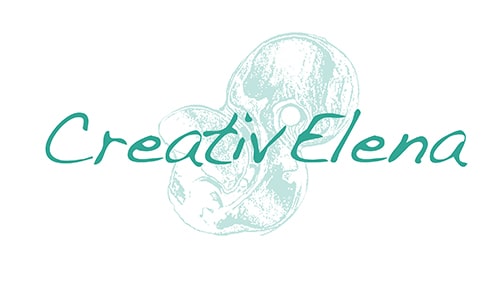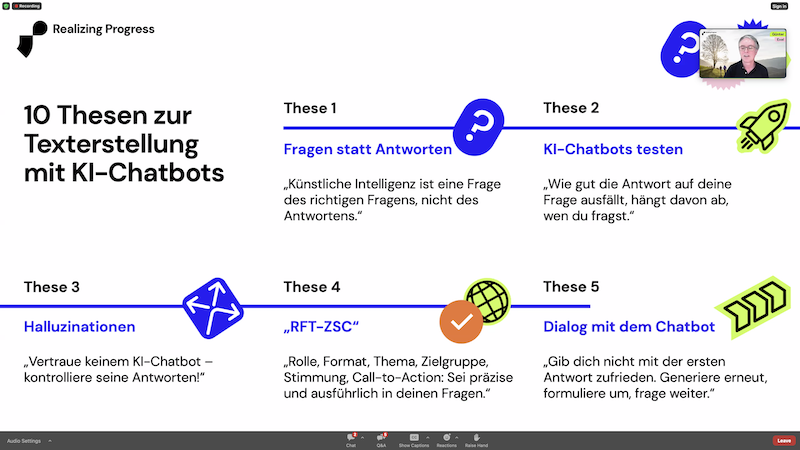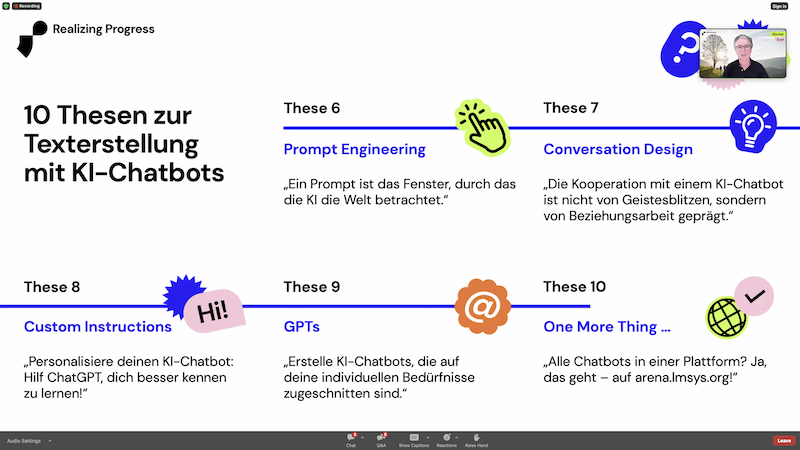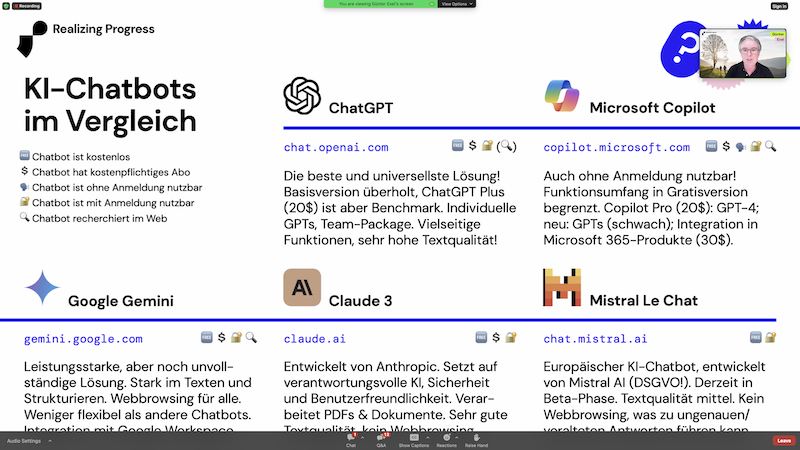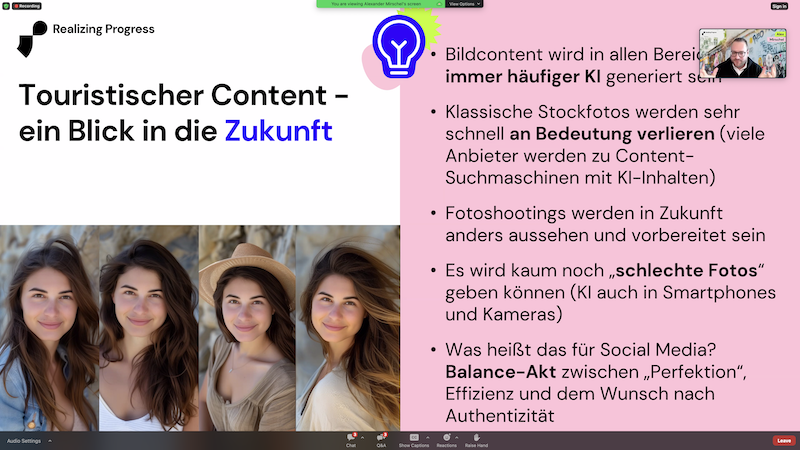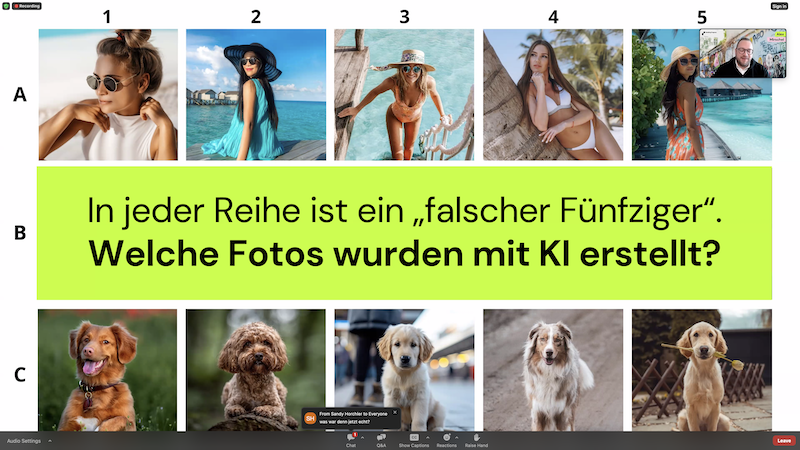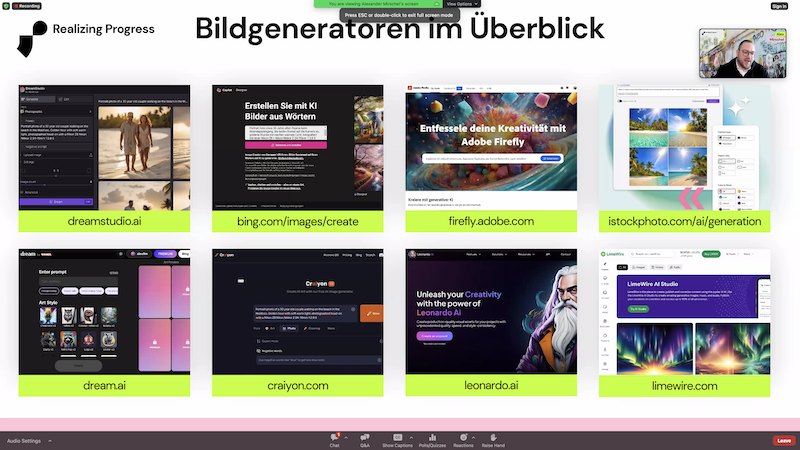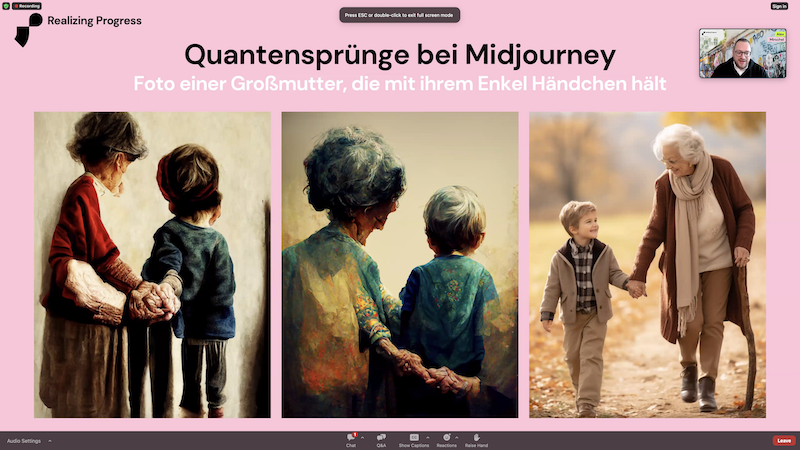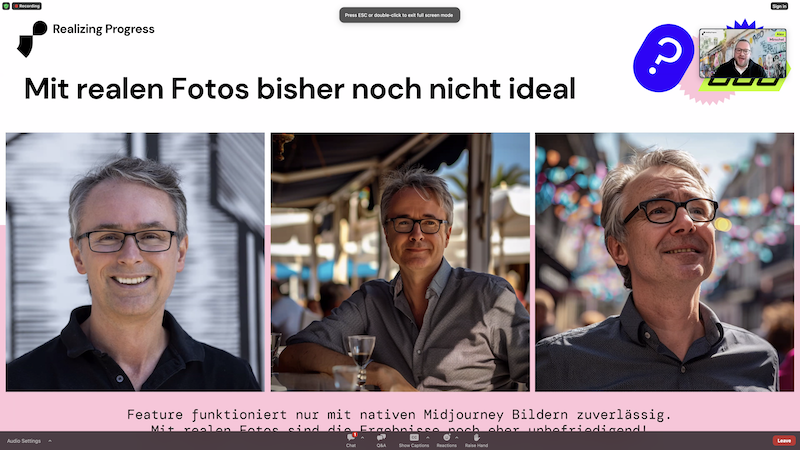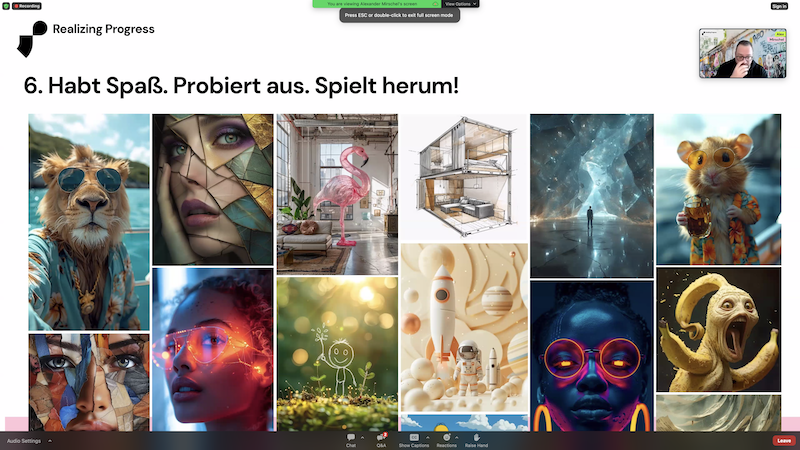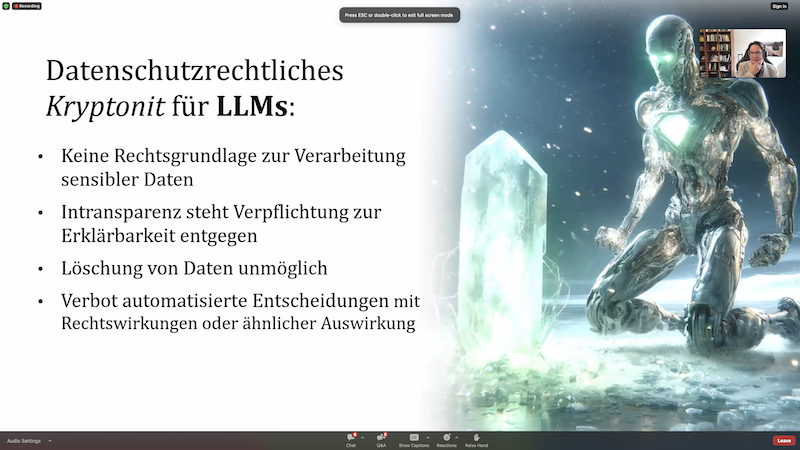I have decided to take the plunge. AI, or artificial intelligence, is a topic that needs to be approached “heads-on” – the more I know about it, the sooner I can tell where it’s going. At least that’s what I thought. Well ..!
Since I’ve been following the #cczk23 Castle Camp Kaprun as well as the Austrian National Tourism Board “AI radar” updates, I am no longer so sure. AI, in all its shining glory (or not), is developing at a speed that is virtually impossible to keep up with as a “non-native, digital nerd”.
It’s really great, therefore, that my dear colleagues of the “Realizing Progress” team hosted an entire day on “AI in tourism“, explaining the status quo as of early April 2024. Because whatever is news now, will be outdated in just a few weeks or months again anyway. Ouch!
A whole day about AI (in tourism): German AI experts Alex Mirschel and Roland Trebo discuss important questions (and answers).
So let’s better get started right away. Alex Mirschel and Roland Trebo kick off the meeting by explaining that “computing performance and efficiency in AI solutions have improved enormously in the last 12 months; many new changes are constantly coming onto the market.” The question is: Will this trend continue? Or will the (speed of) developments change again?
AI, everyone agrees, is here to stay. And yes, AI is set to develop rapidly still, looking at quantum computers, medical research, “generative AI” (i.e. generative, artificial intelligence), and so on. Artificial intelligence has now arrived in all sectors.
Alex Mirschel and Roland Trebo explain: “We are at the peak of the AI hype cycle. Some niche providers will come and go. There are currently between ten and twenty thousand AI tools globally, but the main players among them are here to stay.”
- So how stable is the foundation on which AI stands?
- It is becoming increasingly stable. There is a lot of money involved in AI globally. Improved legal framework conditions will further strengthen the foundation.
- Can AI help with the shortage of skilled labour?
- Numerous work processes can be made (much) more efficient and long-awaited relief can be provided. For small and medium-sized companies in particular, there are opportunities to return from the operational to the strategic – thanks to AI solutions.
- How does the symbiosis of man and machine work in tourism?
- Alex Mirschel and Roland Trebo cite the German travel company TUI as an example, which has drawn up a company agreement on how AI can be used throughout the Group. It is important to deal openly with concerns and fears.
- How is innovation progressing? Is there a changed spirit in the industry?
- Many people still have major concerns about data protection and AI. However, many people are currently embarking on this journey; AI is increasingly being seen as an opportunity.
From prompt to GPT: 10 tips for writing texts using AI tools, explained briefly and concisely by Günter Exel.
After the introduction, Günter Exel provides us with his 10 theses on text creation with AI chatbots in a fascinating, “technical-philosophical” way (anyone who knows Günter would say, typical of him! 😉 ).
Thesis #1: “Working with artificial intelligence is about asking the right questions, not answering them.”
Generative AI has made machines capable of dialogue. Previously, there was a need to learn programming languages; now machines have learnt our language(s). Tools become digital colleagues, and what a difference that makes!
ChatGPT 3.5, Günter explains, provides free basic information and a reasonable overview in response to questions such as “Why should I go on holiday to Lower Austria?”.
ChatGPT 4, in the (paid) Pro version, formulates much better, giving less schematic answers. AI technology enters into dialogue with users, it refers to this dialogue and recognises connections. From update to update, AI gets better and better – better in the sense of, “ever more human”.
According to Günter, if it doesn’t feel like the right answer, then the question is too general or imprecisely formulated. When interacting with AI technologies, it is important to ask the right questions, also known as “prompting”.
Thesis #2: “How well the answer to your question turns out depends on who you ask.”
Among the so-called AI chatbots, there is of course not only ChatGPT (although this all-rounder is still “best in class”). The efficiency of chatbots is differentiated according to speed, reasoning and knowledge. Microsoft has launched Copilot (currently the only free alternative), Google Bard has evolved into Gemini, and then there’s … Claude 3 and Mistral Le Chat!
Günter Exel recommends that we use Gemini as well as ChatGPT. Gemini, developed from Google Bard, is powerful, good at texting and the database is constantly updated. Mistral Le Chat is a GDPR-compliant answer to ChatGPT within the EU and is worth a visit for general questions. The “new kid on the block” is Claude!
Is your head spinning too? Here is an overview of the most popular chatbots in comparison.
Thesis #3: “Don’t trust a chatbot – always check its answers.”
Attention: AI chatbots can actually hallucinate! In other words, AI can invent answers that sound plausible. In practice, this means that all AI responses must always be checked. The systems are getting better and better, but verification is still necessary.
Thesis #4: “Be precise and detailed in your questions.”
Günter Exel emphasises that clear prompts are vital for AI: “The more precisely you say what you want, the better the task can be completed, like explaining to a teenager exactly what he or she has to do. The result will not always be perfect. AI means continuing to work on the results. But with the following prompting guide, you’ve already got a good start.”
- Role. Start with a clear description of your responsibilities.
- Format. Determine the format of the text to be created. Should it be a blog post or an Instagram post?
- Topic. Determine the central topic of the text when you are writing the prompt.
- Target group. Who should the AI-generated text be aimed at? Demographic and psychographic characteristics must be taken into account.
- Mood and function of the text. Should it inform, orientate or entertain?
- Call to action: What should the text achieve? What reaction is desired?
Thesis #5: “Don’t be satisfied with the first answer.”
So how can AI-generated results be improved?
Günter Exel explains that there are essentially “three different techniques. The Regenerate button is best used where the creativity of the answer is important. Prompts can also be reworded, improved, structured, broken down, the desired enquiry can be divided into individual steps, etc. Ultimately, dialogue with AI has become very human.”
Thesis #6: “A prompt is the window through which AI views the world.”
Günter Exel provides us with tips and tricks on the “high school of prompting”, so as to set up prompts and achieve better results in dialogue with AI technologies.
Thesis #7: “Cooperation with an AI chatbot is characterised by working on the relationship.”
Other tips include:
- Specify restrictions (for example, the text should be a maximum of 1500 – 2000 words long).
- Practise your writing style.
- Clear instructions: “I’ll give you a press release as a template, use it as a guide, and here are the new tasks for the new press release.”
- Request a recursive prompt: “Please create better versions of the answer from above.”
AI chatbots do not deliver flashes of inspiration. But: thanks to conversation design, the results are getting better and better.
Thesis #8: “Personalise your AI chatbot: Help ChatGPT to get to know you better.”
Günter Exel suggests providing further explanations on how to deal with AI. For example, describe: Who am I? How should ChatGPT reply to me by default? Which virtual persona do I want to be in the dialogue and address?
Thesis #9: “Create AI chatbots that are tailored to your individual needs.”
In his tips for creating GPTs, Günter highlights context as well as “configuring”, that is, finetuning the basic prompt by giving clearer and more elaborate instructions.
Thesis #10: One More Thing – Chatbot Arena.
Chatbot models can be compared and evaluated in the Chatbot Arena. Günter Exel: “On 10 June 2024, Apple will present its own AI. It’s like the evolutionary race: After that, ChatGPT 4.5. or 5 will certainly be presented, which in turn will be an improvement on the current ChatGPT 4 model – and so on.”
Here is another exciting approach from the discussion in the seminar:
If ANYONE can create content, then more and more AI-generated content will show up in search results. If the AI results are poor, that’s a problem. But: The answers are definitely getting better. In any case, AI can already formulate more SEO-friendly than a human …!
Image generation with AI tools: Nice gimmick or real added value?, presented by Alex Mirschel and Kristine Honig.
Alex Mischel starts by asking a few interesting questions: What is the current state of AI and images? What has happened in the last few months? Are there any use cases for AI image generation in tourism?
There have indeed been huge developments in terms of quality and minimising errors in AI-generated images.
Kristine Honig goes into more detail and emphasises that you should first determine the purpose of the image. Is the image supportive or should it be real? If it is purely to set the mood, AI-generated images have long since surpassed stock photos. These will continue to rapidly lose importance.
Touristischer Content – ein Blick in die Zukunft.
Alex Mischel and Kristine Honig agree that photographers and graphic designers will definitely still be needed, but that their way of working will largely change thanks to AI tools. In future, there will be fewer and fewer “bad” photos: AI will also be built into cameras and smartphones as a standard tool for automatically better image capture or image processing.
This naturally raises an important question: What about the authenticity of images of all kinds then?!
Which of these images were created with the help of an AI? Can we even tell anymore?
The answer is: we can distinguish fewer and fewer “real” images from AI-generated images. In fact, this type of differentiation is already barely possible (see the series of images above: or would you have known straight away that A5 and C3 are the “wrong fifties”?)
Image generators (and their quantum leaps) at a glance.
Of all the AI image generators listed above, Alex Mirschel and Kristine Honig “clearly recommend: Midjourney.” For a fee of currently $10 per month, “you can get very far here, the generated images are very photorealistic. Compared to the results from a year ago, there are real quantum leaps here.”
Where do faces in AI come from? Does this violate personal rights?
Alex Mirschel and Kristine Honig make it clear:
“What I put into the AI is what comes out. When I instruct Midjourney: ‘Create me a picture of a 35-year-old man doing this and that, then that’s the picture that comes out. It is fed from a variety of data, so the AI-generated man may resemble a real person, but is not modelled on anyone in particular.
It is different in the following scenario: if I tell the AI, please put George Clooney on a picture of my region, then this is considered an infringement. Because AI cannot reproduce humans! The technology used to create AI images collects individual pixels from other images piece by piece to generate new ones.
With the so-called “character reference”, AI image tools can be instructed to create an image based on a specific person – even if this person was created artificially. The question that arises is: does the AI actually still recognise what are AI images and what are not?
In response, camera manufacturers such as Canon and Sony have taken the opposite approach. They are working on adding authenticity features to photos. Open AI uses watermarks to identify AI images; Facebook is also (currently) still saying that anyone uploading AI images to Facebook must label them. But as long as the technology itself does not recognise this, it remains thin ice on which we are currently moving …”
In any case, AI-supported image generation is and remains an exciting journey that I find utterly fascinating.
AI-generated images: Not yet ideal with real photos.
Final tip for creating AI images: “Have fun. Try things out. Play around!”
AI and law: A (necessary) update with Peter Hense, Head of Data & Technology at Spirit Legal Germany.
Peter Hense presents himself with his YouTube channel Evil Legal, introducing us to AI regulations in a clear, comprehensive way (thank you very much for that, Peter!).
According to the legal opinion, generative artificial intelligence refers to “language and diffusion models that recognise their own output, as well as being able to improve these results from output to output.”
So where does all the data AI uses to train itself come from? Very often, this data is based on data sets from the World Wide Web from the last 20 years, from so-called “web scrapings”, where several billion websites are stored, from synthetic data and manual data generation. These data sets are mainly sent to the USA and the UK, i.e. where large companies in these sectors have their sites.
Truth be told: There are plenty of legal disputes right now.
Because, according to Peter Hense: “There are currently no copyrights for things created with machines. Outputs from AI can be (re)used by anyone at any time.”
Outputs are not legally protectable as they are “not created by humans”; prompts are usually changed by the system anyway. The risk of unintentional copyright infringement is high; as an example, Peter Hense shows AI-generated images of Spiderman or a woman who looks very, very similar to Grace Kelly in his presentation: “There is little or no insight into the AI’s training data.”
So how do I deal with my own copyrighted works in the age of AI?
- Enter #NoAI in metadata and thus exercise the right to object to further processing
- Add internal additives (such as Glaze and Nightshade) to images to ensure that these images are not used for training AI models. These programs then create blurring, misleading colours etc. and can thus serve as “protection” for your own images.
Another fact: There is (still) no legal basis for processing sensitive data.
Telling an AI to “summarise this medical record or this job application” should be avoided at all costs. AI data cannot be deleted, it’s simply not a safe, legally sound thing to do.
The so-called AI Act will apply in the EU from June 2025: anything that can make its own decisions in any form is covered.
Peter Hense advises us to consider what roles we have in data management: Are we manufacturers, importers, providers, or users of data?
“Most of the obligations lie with the manufacturers; users only have the obligation to buy clean systems and ensure that they are legally compliant,” says Peter Hense. And: “Most applications of the AI Act concern high-risk applications. This identifies AI systems. Caution: If you connect a database, you are automatically in the provider role. This means you are 100% subject to the obligations of the AI Act.”
Well!
Trust you’re still having fun using KI models – let’s see what the future holds.
